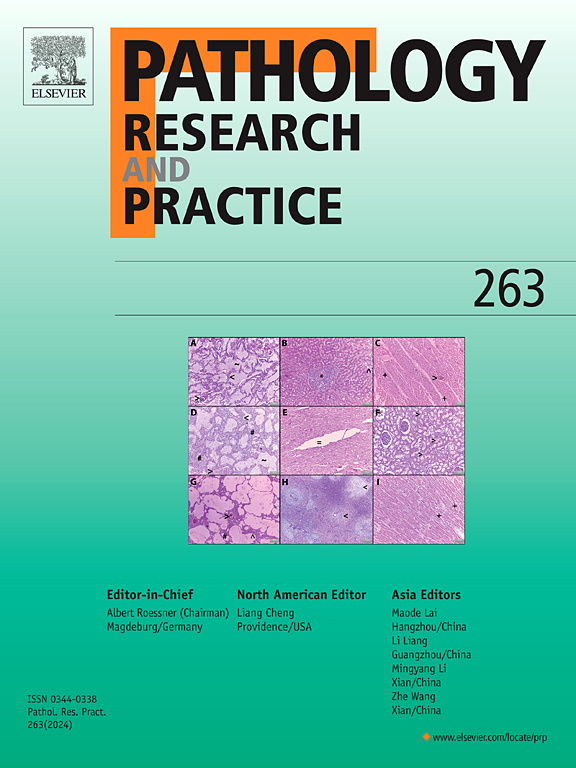The Fritillaria alkaloid peiminine acts as a chemosensitizer to potentiate oxaliplatin efficacy against gastric cancer
IF 3.2
4区 医学
Q2 PATHOLOGY
引用次数: 0
Abstract
Background
Fritillaria walujewii Regel (Xinjiang Bei-Mu), an authentic ("Dao-di") medicinal herb documented in Chinese pharmacopoeias, is traditionally used to treat respiratory disorders. Its principal steroidal alkaloid, peiminine (PMI), demonstrates significant anticancer activity. Oxaliplatin (Oxa), a first-line chemotherapeutic cornerstone for gastric cancer (GC), is limited clinically by intrinsic chemoresistance. Natural product-derived monomers represent a promising strategy for developing chemosensitizers to overcome such resistance. However, the potential of PMI to counteract Oxa chemoresistance and its underlying mechanisms remain unexplored, warranting comprehensive investigation. To determine the chemosensitizing effects of PMI in combination with Oxa for GC treatment, specifically evaluating its capacity to reverse chemoresistance and enhance therapeutic efficacy.
Materials and methods
The effects of PMI combined with Oxa versus Oxa monotherapy on GC cells (HGC27, BGC823, MKN45) were assessed using CCK-8, colony formation, and flow cytometry apoptosis assays to evaluate cell proliferation and apoptosis. Subsequently, qPCR-based apoptosis pathway array and transcriptome sequencing (RNA-seq) were used to differentially expressed apoptosis-related genes and to uncover key signaling pathways mediating PMI-induced Oxa sensitization. The protein expression level of Bcl-2, Bax, PARP, cytochrome c (CYCS), Caspase-3/9, RAS and AKT was determined by Western blot. Finally, the efficacy of PMI+Oxa combination therapy was validated in vivo using both cell line-derived xenograft (CDX) and patient-derived xenograft (PDX) models.
Results
PMI (50 μM) synergized with Oxa (2.5 μM), significantly enhancing apoptosis and suppressing proliferation in GC cells. Mechanistically, the combination activated the mitochondrial apoptosis pathway by upregulating Bax and inducing the release of CYCS and the cleavage of caspase-9, caspase-3, and PARP. Concurrently, it suppressed the RAS/PI3K/AKT survival pathway by inhibiting Ras-GTP and phospho-AKT. In CDX models, PMI (2 mg/kg) + Oxa achieved a tumor growth inhibition (TGI) rate of > 80.8 %, compared to 20.4 % for Oxa alone. Strikingly, in PDX models which preserve clinical tumor heterogeneity—the combination induced a TGI of > 70 % without exacerbating systemic toxicity.
Conclusions
PMI is a novel dual-targeting chemosensitizer that overcomes Oxa resistance by simultaneously activating intrinsic apoptosis and inhibiting pro-survival signaling. Its demonstrated efficacy in clinically relevant PDX models highlights its significant translational potential for platinum-resistant GC therapy.
贝母生物碱贝亚明作为化学增敏剂增强奥沙利铂对胃癌的疗效
贝母(beltillaria walujewii Regel,新疆贝母)是中国药典中记载的正宗(“道底”)草药,传统上用于治疗呼吸系统疾病。其主要的甾体生物碱(PMI)显示出显著的抗癌活性。奥沙利铂(Oxa)是胃癌(GC)的一线化疗基石,但其内在化疗耐药在临床上受到限制。天然产物衍生的单体代表了开发化学增敏剂以克服这种耐药性的有希望的策略。然而,PMI对抗Oxa化学耐药的潜力及其潜在机制仍未被探索,需要进行全面的研究。确定PMI联合Oxa治疗GC的化疗增敏作用,具体评价其逆转化疗耐药和提高治疗效果的能力。材料和方法采用CCK-8、集落形成和流式细胞术细胞凋亡检测方法评估PMI联合Oxa与Oxa单药对GC细胞(HGC27、BGC823、MKN45)的增殖和凋亡的影响。随后,利用基于qpcr的凋亡通路阵列和转录组测序(RNA-seq)技术,研究细胞凋亡相关基因的差异表达,揭示介导pmi诱导Oxa致敏的关键信号通路。Western blot检测Bcl-2、Bax、PARP、细胞色素c (CYCS)、Caspase-3/9、RAS、AKT蛋白的表达水平。最后,使用细胞系来源的异种移植(CDX)和患者来源的异种移植(PDX)模型验证PMI+Oxa联合治疗的有效性。结果spmi(50 μM)与Oxa(2.5 μM)协同作用,显著促进GC细胞凋亡,抑制细胞增殖。机制上,联合用药通过上调Bax,诱导CYCS的释放和caspase-9、caspase-3、PARP的裂解,激活线粒体凋亡通路。同时,它通过抑制RAS - gtp和phospho-AKT抑制RAS/PI3K/AKT存活通路。在CDX模型中,PMI(2 mg/kg) + Oxa的肿瘤生长抑制(TGI)率为>; 80.8 %,而Oxa单独的TGI率为20.4 %。引人注目的是,在保持临床肿瘤异质性的PDX模型中,该组合诱导的TGI为>; 70 %,而不会加剧全身毒性。结论spmi是一种新型的双靶向化学增敏剂,通过同时激活细胞内凋亡和抑制促生存信号来克服Oxa耐药。在临床相关的PDX模型中显示的疗效突出了其在铂耐药GC治疗中的重要转化潜力。
本文章由计算机程序翻译,如有差异,请以英文原文为准。
求助全文
约1分钟内获得全文
求助全文
来源期刊
CiteScore
5.00
自引率
3.60%
发文量
405
审稿时长
24 days
期刊介绍:
Pathology, Research and Practice provides accessible coverage of the most recent developments across the entire field of pathology: Reviews focus on recent progress in pathology, while Comments look at interesting current problems and at hypotheses for future developments in pathology. Original Papers present novel findings on all aspects of general, anatomic and molecular pathology. Rapid Communications inform readers on preliminary findings that may be relevant for further studies and need to be communicated quickly. Teaching Cases look at new aspects or special diagnostic problems of diseases and at case reports relevant for the pathologist''s practice.

 求助内容:
求助内容: 应助结果提醒方式:
应助结果提醒方式:


